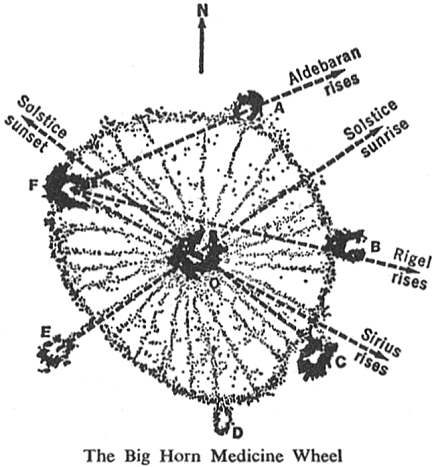
Journal of Geomancy vol. 3 no. 3, April 1979
{69}
There is much mystery concerning the medicine wheels scattered throughout the Northwestern states and several nearby Canadian provinces. While the original function of these wheels has long been forgotten, the structures are usually considered sacred to the Indians. In another short article, this author presented one of the unusual Indian legends concerning the famous Big Horn Medicine Wheel.

Medicine wheels generally are in the form of a great circle consisting of a central circle or rock pile (hub). From this, lines of rock radiate like spokes. Often large piles of rocks (cairns) are associated with these, as are occasionally one or more concentric circles. Medicine wheels range up to 300 feet in diameter. The number of spokes varies considerably. Most of the medicine wheels, however, are simply large cairns without rings or spokes. Medicine wheels are normally found on the rolling prairie although one of the most famous, the Big Horn (Wyoming) Medicine Wheel, is in rugged terrain. The prairie medicine wheels indicate semi-permanent dwelling. Big Horn does not. There are over 30 medicine wheels in Alberta, 10 in Saskatchewan, 1 small one in the Dakotas, 4 in Montana and 3 in Wyoming.
A detailed study found that over half of the medicine wheels do have astronomical significance. These have spokes or special features which point within 2° of the summer solstice. The Big Horn Medicine Wheel is the best known example. It marks the summer solstice and three main stars – Sirius, Rigel and Aldebaran. The majority of wheels also point to the rising point of these three stars. A medicine wheel at Majorville, Alberta, has the same number of spokes as the Big Horn Wheel.
This Majorville Medicine Wheel has been dated as over 5000 years old and thereby dates with the Egyptian pyramids, Stonehenge and similar structures in New England. The Moose Mountain Medicine Wheel in Southeastern Saskatchewan –twice the Size of the Big Horn Wheel – has one of its spokes extended further than the others, like the sunrise spoke of the Big Horn Medicine Wheel. These two medicine wheels are almost twins. The Moose Mountain Medicine Wheel has been dated at about 2000 years old.
In the southwestern and central U.S.A., the Indians used kivas for both astronomical observatories and religious ceremonies. The planet Venus, in contrast, was used in the kivas. Further south, the ancient Mayans used a simple circle with stone markers also keying on Venus and the solstices.
Thus the American Indians used both medicine wheels and kivas for astronomical sightings. Consider that the medicine wheels date back to Stonehenge (an observatory) and the Egyptian pyramids. The medicine wheels have only been found in Northwestern America. But, the primary use of the Indian Medicine Wheels is still a major mystery.